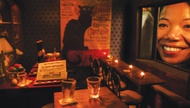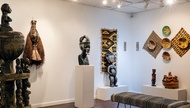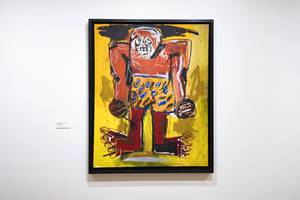
Tested Ground Through September 16, Monday-Friday, 9 a.m.-5 p.m.; Saturday, noon-5 p.m., $2-$5 suggested donation. UNLV’s Marjorie Barrick Museum of Art, 702-895-3381.
Tested Ground, through September 16, brings whimsy, humor, beauty and vision to the Barrick Museum. Curated and hung by Barrick staff led by Interim Director Alisha Kerlin, the exhibition includes more than 150 works by five Nevada-linked artists: Andreana Donahue, Alexa Hoyer, Joan Linder, Jenny Odell and Nicolas Shake.
Probing the relationship between art-making and material culture, Tested Ground features drawings, quilts, photographs, installations, sculptures and a rubbing. The exhibition documents the slippery identity of everyday objects—a toupée, say, or a pincushion—when their functions shift from practical to aesthetic. It’s almost as if the objects were shirking their purpose and rematerializing as art.
Among the standouts are Shake’s sculptures. Working with polymer, Shake makes molds from discarded tires, transforming tread into lines, or strips, of plastic. Combining strips into panels, he constructs textural sculptures that appear woven, save for the plastic sheen. The polymer absorbs oil from the rubber, altering its creamy color; debris embedded in the tread adds surface grain. The discarded tires are everywhere present as material without being literally represented.
In the striking “TPV,” for example, Shake uses the strips to create a lopsided circular relief nearly six feet in diameter, its fractaled form rising in prismatic peaks and receding in enigmatic troughs, as if the sculpture were an aerial shorthand of phantom roadway prints. The mesmerizing whole might suggest the visual antics of Op Art, were it not for the soothing monochrome and sensuous curves softening the geometry.
Discarded objects also populate works by Hoyer and Odell. At local shooting ranges, Hoyer photographed bullet-ridden found assemblages—denatured items like cushions, prosthetic limbs and TVs anonymously combined on-site with wood and metal into new targets. Isolated at the center (or bull’s eye) of the portrait, the assemblages pose like proud denizens of the desert.
Odell’s objects, too, take on gravitas through isolation. Part of her ongoing “Bureau of Suspended Objects” project, Odell’s installation features items culled from refuse and painstakingly researched, each with identifying label. The attention the artist lavishes on her archive prompts viewers to rethink detritus as part of a complex, social fabric in which humans themselves teeter on the verge of extinction.
In Linder’s work, objectification extends to nature. Her 9-by-9-foot hyper-realistic drawing—half backyard, half chemical dump—confronts viewers with catastrophe while disarming them with loveliness. “Toxic Archives,” her haunting suite of 70 small-format drawings, are exact renderings of actual historical documents, including photocopy blurs and coffee stains. “Human Radiation Studies: Remembering the Early Years,” for example, becomes even more terrifying when witnessed by the artist’s hand. Donahue also emphasizes the role of the artist in hand-dying and stitching quilts that blur high and low art.
Overall, Tested Ground engages questions about how artists translate material culture into artworks. It does so convincingly. A summer must-see.






